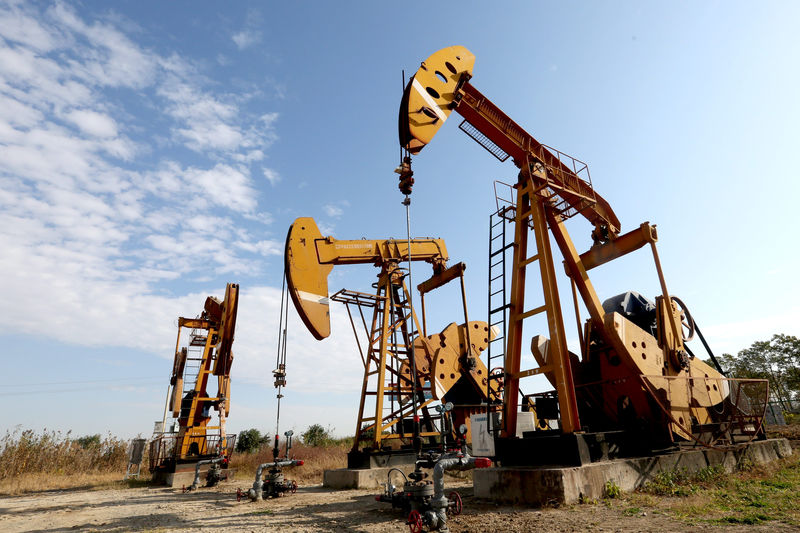Investing.com - The bull run in oil showed little signs of slowing on Monday, with Brent soaring 3% to hit $85 per barrel as the fourth quarter began amid heightened worries about the Iranian sanctions crisis and how badly that could deprive the world of much-needed crude.
Oil prices also rose in response to a trade deal reached on Monday by the United States and Canada to replace the North American Free Trade Agreement. The new United States-Mexico-Canada Agreement (USMCA), which incorporates an earlier pact between Washington and Mexico City, could see Mexico buy more oil from the U.S., traders said.
Analysts estimate that Iran, the world’s fourth-largest oil producer and the third-most important exporter in the Organization of the Petroleum Exporting Countries (OPEC), will be prevented from shipping up to 1.5 million barrels per day (bpd) when new U.S. sanctions against Tehran’s nuclear program come on board Nov. 4. At its 2018 peak in May, Iran exported 2.71 million bpd, nearly 3% percent of daily global crude consumption.
Brent crude, the global benchmark for oil traded on London’s Intercontinental Exchange, was up 3%, or $2.47, at $85.20 a barrel by 3:02 PM ET (19:02 GMT), after surging to as high as $85.44 earlier, a peak not seen since November 2014. Brent ‘s near-6% gain for September was its highest for this year.
Crude oil WTI futures rallied past an equally-important target of $75. WTI settled up 2.8%, or $2.05, at $75.30 a barrel, after hitting $75.48 earlier, its highest level since July. WTI rose by about 5% in September.
Both Brent and WTI are up about 25%, on average year-to-date, on worries that neither the combined forces of Russian and Saudi Arabian production or the sheer dynamism of U.S. shale, which flooded the world with cheap oil between 2014 and 2017, will be enough to counter the projected global shortfall in supply from November. Many analysts now think $100 for Brent might be possible by the year end or in early 2019.
Trump and Saudi King Speak
“Bottom line, the oil markets are staying strong as oil will be undersupplied going into winter,” Phil Flynn, energy analyst at Price Futures Group in Chicago, wrote on Monday. “Conventional supplies of oil are drying up and shale oil process can’t keep pace with increasing conventional and non-conventional oil production rates.”
Arabian TV reported that President Donald Trump spoke on the phone Saturday with Saudi King Salman bin Abdulaziz after the U.S. leader accused OPEC last week of “ripping off” the world with high oil prices, essentially caused by the sanctions brought on by Washington. The two leaders spoke on “issues of regional concern”, the report said, without elaborating.
Bloomberg said in a report that hedge funds were watching Trump’s back-and-forth with Saudi Arabia for any signs that the U.S. might take action against the kingdom or other key OPEC members. Traders are also expected to be closely following speeches by Saudi Energy Minister Khalid Al-Falih in Morocco later on Monday and in Russia on Thursday for signs of supply concessions after he rebuffed earlier Trump calls for more production.
Hedge Funds Raise Bullish Wagers On U.S. Crude
Hedge funds have added to their bullish wagers in WTI since U.S. Energy Secretary Rick Perry refuted media and other speculation last week that Trump might release emergency oil supplies from the U.S. Strategic Petroleum Reserve (SPR) to subdue the oil rally, as well as rising gasoline prices at U.S. pumps.
Data from the U.S. Commodity Futures Trading Commission (CFTC) on Friday showed hedge funds raising their net longs on both futures and options of U.S. crude in New York and London by 3,728 contracts to 346,566 during the week ended Sept. 25.
While Trump is bent on targeting Iran’s nuclear program through sanctions, the president is also aware that high oil prices are a political risk for him and his fellow Republicans in midterm elections due in November. In the U.S. East Coast, pump prices were up 26 cents from a year ago to average at $2.844 per gallon last week, while in the West Coast, they rose nearly 35 cents to $3.3350.
U.S. Oil Drilling On Decline
Drilling activity for oil in the United States seems to be on the decline, though marginally for now. Oil services firm Baker Hughes reported on Friday said that the number of rigs drilling for oil in the U.S. fell by three over the week to 863. Infrastructure bottlenecks could also hamper higher U.S. shale production, industry analysts say.
“Without the risk of an SPR release, and the woefully short response from OPEC last week, I think the market has a ‘green light’ for higher prices and I could see new highs in WTI above the continuation high of $75.27 in the near term,” Scott Shelton, energy broker and analyst with ICAP (LON:NXGN) in Durham, N.C., wrote on Monday.
In other energy trading, gasoline RBOB futures rose 2.04% to $2.1332 a gallon, while heating oil increased by 2.7% to $2.4118 a gallon. Natural gas futures surged 3.3% to $3.106 per million British thermal units.
